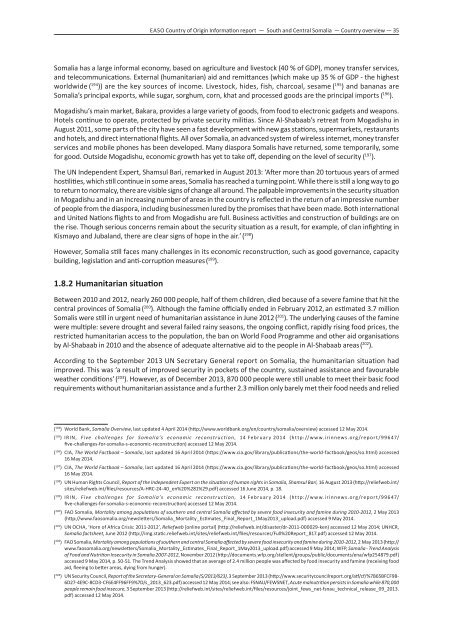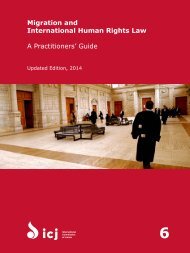You also want an ePaper? Increase the reach of your titles
YUMPU automatically turns print PDFs into web optimized ePapers that Google loves.
EASO Country of Origin Information report — South and Central <strong>Somalia</strong> — Country overview — 35<br />
<strong>Somalia</strong> has a large informal economy, based on agriculture and livestock (40 % of GDP), money transfer services,<br />
and telecommunications. External (humanitarian) aid and remittances (which make up 35 % of GDP - the highest<br />
worldwide ( 194 )) are the key sources of income. Livestock, hides, fish, charcoal, sesame ( 195 ) and bananas are<br />
<strong>Somalia</strong>’s principal exports, while sugar, sorghum, corn, khat and processed goods are the principal imports ( 196 ).<br />
Mogadishu’s main market, Bakara, provides a large variety of goods, from food to electronic gadgets and weapons.<br />
Hotels continue to operate, protected by private security militias. Since Al‐Shabaab’s retreat from Mogadishu in<br />
August 2011, some parts of the city have seen a fast development with new gas stations, supermarkets, restaurants<br />
and hotels, and direct international flights. All over <strong>Somalia</strong>, an advanced system of wireless internet, money transfer<br />
services and mobile phones has been developed. Many diaspora Somalis have returned, some temporarily, some<br />
for good. Outside Mogadishu, economic growth has yet to take off, depending on the level of security ( 197 ).<br />
The UN Independent Expert, Shamsul Bari, remarked in August 2013: ‘After more than 20 tortuous years of armed<br />
hostilities, which still continue in some areas, <strong>Somalia</strong> has reached a turning point. While there is still a long way to go<br />
to return to normalcy, there are visible signs of change all around. The palpable improvements in the security situation<br />
in Mogadishu and in an increasing number of areas in the country is reflected in the return of an impressive number<br />
of people from the diaspora, including businessmen lured by the promises that have been made. Both international<br />
and United Nations flights to and from Mogadishu are full. Business activities and construction of buildings are on<br />
the rise. Though serious concerns remain about the security situation as a result, for example, of clan infighting in<br />
Kismayo and Jubaland, there are clear signs of hope in the air.’ ( 198 )<br />
However, <strong>Somalia</strong> still faces many challenges in its economic reconstruction, such as good governance, capacity<br />
building, legislation and anti‐corruption measures ( 199 ).<br />
1.8.2 Humanitarian situation<br />
Between 2010 and 2012, nearly 260 000 people, half of them children, died because of a severe famine that hit the<br />
central provinces of <strong>Somalia</strong> ( 200 ). Although the famine officially ended in February 2012, an estimated 3.7 million<br />
Somalis were still in urgent need of humanitarian assistance in June 2012 ( 201 ). The underlying causes of the famine<br />
were multiple: severe drought and several failed rainy seasons, the ongoing conflict, rapidly rising food prices, the<br />
restricted humanitarian access to the population, the ban on World Food Programme and other aid organisations<br />
by Al‐Shabaab in 2010 and the absence of adequate alternative aid to the people in Al‐Shabaab areas ( 202 ).<br />
According to the September 2013 UN Secretary General report on <strong>Somalia</strong>, the humanitarian situation had<br />
improved. This was ‘a result of improved security in pockets of the country, sustained assistance and favourable<br />
weather conditions’ ( 203 ). However, as of December 2013, 870 000 people were still unable to meet their basic food<br />
requirements without humanitarian assistance and a further 2.3 million only barely met their food needs and relied<br />
( 194 ) World Bank, <strong>Somalia</strong> Overview, last updated 4 April 2014 (http://www.worldbank.org/en/country/somalia/overview) accessed 12 May 2014.<br />
( 195 ) IRIN, Five challenges for <strong>Somalia</strong>’s economic reconstruction, 14 February 2014 (http://www.irinnews.org/report/99647/<br />
five‐challenges‐for‐somalia‐s‐economic‐reconstruction) accessed 12 May 2014.<br />
( 196 ) CIA, The World Factbook – <strong>Somalia</strong>, last updated 16 April 2014 (https://www.cia.gov/library/publications/the‐world‐factbook/geos/so.html) accessed<br />
16 May 2014.<br />
( 197 ) CIA, The World Factbook – <strong>Somalia</strong>, last updated 16 April 2014 (https://www.cia.gov/library/publications/the‐world‐factbook/geos/so.html) accessed<br />
16 May 2014.<br />
( 198 ) UN Human Rights Council, <strong>Report</strong> of the Independent Expert on the situation of human rights in <strong>Somalia</strong>, Shamsul Bari, 16 August 2013 (http://reliefweb.int/<br />
sites/reliefweb.int/files/resources/A‐HRC-24-40_en%20%281%29.pdf) accessed 16 June 2014, p. 18.<br />
( 199 ) IRIN, Five challenges for <strong>Somalia</strong>’s economic reconstruction, 14 February 2014 (http://www.irinnews.org/report/99647/<br />
five‐challenges‐for‐somalia‐s‐economic‐reconstruction) accessed 12 May 2014.<br />
( 200 ) FAO <strong>Somalia</strong>, Mortality among populations of southern and central <strong>Somalia</strong> affected by severe food insecurity and famine during 2010-2012, 2 May 2013<br />
(http://www.faosomalia.org/newsletters/<strong>Somalia</strong>_Mortality_Estimates_Final_<strong>Report</strong>_1May2013_upload.pdf) accessed 9 May 2014.<br />
( 201 ) UN OCHA, ‘Horn of Africa Crisis: 2011-2012’, Reliefweb [online portal] (http://reliefweb.int/disaster/dr-2011-000029-ken) accessed 12 May 2014; UNHCR,<br />
<strong>Somalia</strong> factsheet, June 2012 (http://img.static.reliefweb.int/sites/reliefweb.int/files/resources/Full%20<strong>Report</strong>_817.pdf) accessed 12 May 2014.<br />
( 202 ) FAO <strong>Somalia</strong>, Mortality among populations of southern and central <strong>Somalia</strong> affected by severe food insecurity and famine during 2010-2012, 2 May 2013 (http://<br />
www.faosomalia.org/newsletters/<strong>Somalia</strong>_Mortality_Estimates_Final_<strong>Report</strong>_1May2013_upload.pdf) accessed 9 May 2014; WFP, <strong>Somalia</strong> - Trend Analysis<br />
of Food and Nutrition Insecurity in <strong>Somalia</strong> 2007-2012, November 2012 (http://documents.wfp.org/stellent/groups/public/documents/ena/wfp254879.pdf)<br />
accessed 9 May 2014, p. 50-51. The Trend Analysis showed that an average of 2.4 million people was affected by food insecurity and famine (receiving food<br />
aid, fleeing to better areas, dying from hunger).<br />
( 203 ) UN Security Council, <strong>Report</strong> of the Secretary‐General on <strong>Somalia</strong> (S/2013/623), 3 September 2013 (http://www.securitycouncilreport.org/atf/cf/%7B65BFCF9B-<br />
6D27-4E9C-8CD3-CF6E4FF96FF9%7D/s_2013_623.pdf) accessed 12 May 2014; see also: FSNAU/FEWSNET, Acute malnutrition persists in <strong>Somalia</strong> while 870,000<br />
people remain food insecure, 3 September 2013 (http://reliefweb.int/sites/reliefweb.int/files/resources/joint_fews_net‐fsnau_technical_release_09_2013.<br />
pdf) accessed 12 May 2014.



